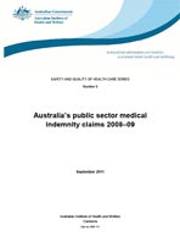This report presents data on the number, nature and costs of public sector medical indemnity claims for the period 2004–05 to 2008–09, with a focus on 2008–09 claims.
Public sector medical indemnity claims for 2008–09
A new claim is created when a dollar amount (reserve) is placed against the costs expected to arise from allegations of faulty health service provision. There were 1,291 new public sector claims in 2008–09. The most frequently involved clinician specialties were General practice—procedural (10%), Obstetrics and gynaecology and Emergency medicine (both 7%). The health service contextsmost often implicatedwere Accident and emergency, Obstetrics and General surgery.
Of the 1,867 claims closed in 2008–09, 51% cost less than $10,000 to close. The claimant pursuing the claim received a payment for 39% of closed claims, whether the claimant was the patient (17%), some party other than the patient (8%) or multiple claimants (14%).
Claims opened between 2004–05 and 2008–09
There were fewer new claims in 2008–09 (1,291) than in any of the four previous years (about 1,330 to 2,000 claims per year).
There was little change over time in the health service context implicated in the claim, except for a spike in General surgery in 2005–06 (30%, compared with 13–16% in other years) and a rise in Gynaecology claims (from 5% in 2005–06 to 11% in 2008–09). Allegations of Neuromusculoskeletal and movement-related harmful effects were reported for a higher proportion of claims each year (20–25%) than allegations of harmful effects to any other physiological or neurological system.
Claims closed between 2004–05 and 2008–09
There were about the same number of claims closed in 2008–09 (1,867) as in the four previous years (about 1,800 to 2,200 claims per year).
The proportion of claims closed for large amounts and for more significant harm tended to rise between 2004–05 and 2008–09. The proportion of claims closed for $100,000 or more, doubled from 9% in 2004–05 to 19% in 2008–09. Over this period, there was a consistent decline in the proportion associated with temporary harm (from 29% to 20%) and an increase in the proportions associated with both major harm (from 21% to 25%) and the patient’s death (from 14% to 22%).
The alleged problem in health service delivery was associated with Procedure—for instance, a surgical procedure or childbirth delivery—in around one-third of the claims. Post-operative complications were alleged more often than any other Procedure subcategory.
Accident and emergency claims
Accident and emergency claims accounted for almost 1,500 of the claims closed between 2004–05 and 2008–09. Emergency medicine was the primary clinician specialty associated with 70% of these claims. Allegations of Neuromusculoskeletal and movement-related effects were reported for 37% of claims, and the most frequently alleged problem in health service delivery was Diagnosis (55% of claims).



